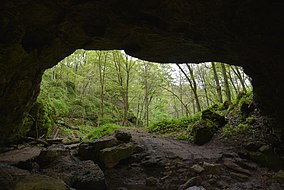
This park contains more caves than any other state park in Iowa. A trail system links the caves, formations, and overlooks while providing a scenic hiking experience. Many areas on these trails have seen new construction, making the journey to the caves safer. Most of the caves may be entered by persons of average physical ability, but some are more advanced. However the park’s caves were closed to humans between 2010 and April 2012 in the hopes of protecting the resident bats from white nose syndrome.
The park is in the Driftless Area of Iowa. This region escaped being glaciated in the last ice age, while regions to the east and west were not spared. The park has been subjected to hundreds of thousands of years of natural non-glacial erosion.
The park’s caves, limestone formations and rugged bluffs represent a step back in geological time of thousands of years. Stalactites once hung from the ceilings and stalagmites rose from the floor. Souvenir hunters have robbed the caves of this rare beauty, but many formations remain. The park’s limestone caves, arches and chimneys including Dancehall Cave, Hernado’s Hideaway, Shinbone Cave, Wye Cave, and an unmarked cave within the Dancehall Cavern locally known as Steelgate Cave.
A BIT OF HISTORY
Artifacts such as pottery, as well as tools and projectile points made of stone have been found in the caves and surrounding area. These discoveries indicate that the Maquoketa Caves area has been of interest to humans for hundreds, perhaps thousands, of years. Early recorded history tells that the Native Americans in the area were likely visitors to the Raccoon Creek valleys. The first Euro-American explorers first visited the caves as late as the mid-1830s. The area was originally known as Morehead Caves or Burt’s Cave. It had become a popular place for exploration, picnics, parties, and dances by the 1860s. A dance floor was constructed north of Natural Bridge in 1868, and a pavilion, which was used until the 1920s, was built sometime later. By the turn of the 20th century the area had become seriously degraded, and its popularity declined. (wiki)


